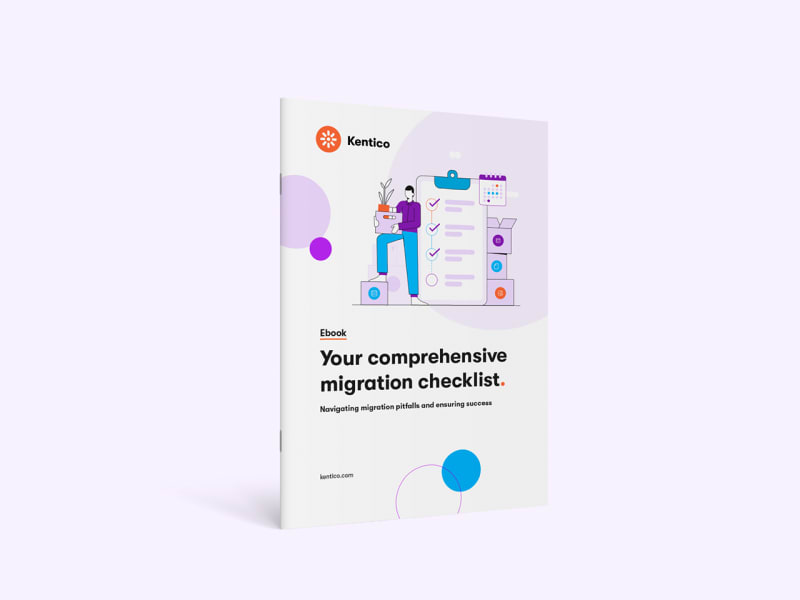In today's ever-evolving digital landscape, where a robust online presence is paramount for business success, digital experience platforms (DXPs) and Content Management Systems (CMS) play a pivotal role. From facilitating seamless content creation to ensuring a memorable user experience, these platforms form the backbone of a company's digital strategy.
However, businesses often hesitate to migrate systems due to concerns such as cost implications, fear of disruption, lack of in-house expertise, legacy system dependencies, resistance to change, security risks, compliance complexities, and unrealistic timeframes. The perceived stability of an existing solution, combined with the perceived difficulty of transitioning away from it, often casts a deeper shadow over the decision-making process.
Yet it is worth considering whether the perceived pains of migration outweigh the long-term limitations of remaining on an outdated system. Moving away from an unfunctional or ineffective solution can unlock improved efficiency, innovation, and sustained success in an increasingly digital landscape.
10 Ways Your Outdated Solution Is Letting You Down
You might be inclined to think, “If it ain’t broke, don’t fix it.” However, migration is not merely a technical choice but a strategic imperative. An outdated solution can be quietly “broke” in more ways than you might realize.
1. Lower Return On Investment (ROI)
Outdated DXP and CMS platforms struggle to meet modern digital demands, leading to missed opportunities for cost savings, revenue growth, and improved user experiences. These systems often incur high maintenance costs through custom patches and extended support. A fragmented tech stack further reduces efficiency, while a modern DXP centralizes multichannel management and improves overall ROI.
2. Impeded Agility
Legacy DXP platforms struggle to support new functionality, limiting your ability to adapt to changing market conditions. This lack of agility can result in missed opportunities and reduced market relevance. Modern DXPs introduce innovative features that help organizations stay responsive and competitive.
3. Inadequate Customer Experience
Outdated platforms often fail to deliver the seamless, personalized digital experiences customers expect. Slow load times, limited marketing tools, and inconsistent content delivery across channels can weaken brand perception. Modern DXPs support consistent, multichannel experiences that improve customer satisfaction and boost marketing autonomy.
4. Increased Data Security Risks
Delaying DXP migration or upgrades exposes organizations to cybersecurity risks. Unsupported platforms may lack essential security features, making them vulnerable to data breaches and malware. These risks can result in financial, legal, and reputational damage. Modern DXPs include advanced security measures to protect sensitive data.
5. Growing Compliance Concerns
Outdated systems can struggle to keep pace with evolving regulations such as GDPR and CCPA. Non-compliance increases the risk of penalties, audits, and legal action. Staying current with DXP upgrades helps ensure ongoing regulatory compliance.
6. Decreased Marketing Efficiency And Effectiveness
Limited content management capabilities can slow campaign launches, reduce personalization, and make it harder to keep up with digital marketing trends. Newer DXPs offer improved workflows, user-friendly interfaces, and centralized digital asset management, boosting marketing productivity.
7. Vendor Misalignment
As vendors evolve their services and technologies, outdated platforms can become increasingly misaligned. This often leads to custom workarounds, higher maintenance costs, and missed innovation opportunities. Migrating to a modern DXP improves vendor alignment and reduces dependency on legacy technology.
8. Globalization Challenges
Legacy systems may struggle to support regional content requirements, languages, and regulations. Poor localization can reduce engagement, damage brand perception, and limit global growth. Advanced DXPs enable better content adaptation across regions and markets.
9. Reduced Scalability
As digital demands increase, outdated systems often struggle with higher traffic, growing content volumes, and new functionality. This can result in performance issues, downtime, and limited growth potential. Modern DXPs are designed to scale alongside your business.
10. Lack Of Future-Proofing
Delaying migration increases technical debt, often requiring larger investments later to address limitations or adopt new technologies. Modern DXPs help future-proof digital strategies by supporting ongoing innovation and emerging capabilities.
The “if it ain’t broke, don’t fix it” mindset overlooks the strategic importance of migration. Delaying action risks reduced ROI, limited agility, compromised customer experiences, and increased operational risk. A planned transition to a modern DXP addresses immediate challenges while positioning your organization for long-term digital success.
The Numbing Agent: Migration Toolkits
In an ideal scenario, migrating from one platform to another would be supported by a dedicated migration toolkit provided by the new vendor. In reality, this rarely happens.
The next best option is a universal migration toolkit that supports migration from multiple platforms to a single destination. While still uncommon, this approach can significantly simplify and accelerate the migration process.
A universal migration toolkit is a set of pre-built tools, scripts, and resources designed to support the secure transfer of data, content, and configurations from an existing system to a modern platform.
Key features of a universal migration toolkit include:
- Standardized process: A universal migration toolkit provides a standardized process for migrating data and configurations, reducing the complexity of the migration workflow. Standardization ensures consistency across different migrations, making it easier to manage and troubleshoot potential issues.
- Efficiency and automation: Toolkits offer automation features that help automate repetitive tasks involved in the migration process. Automation improves efficiency, reduces manual errors, and accelerates the overall migration timeline.
- Reduced dependency on custom development: The toolkit may offer pre-built connectors and adapters for common systems and databases, reducing the need for custom development efforts. This minimizes the risk of compatibility issues and accelerates the integration process.
- Comprehensive data mapping: Universal migration toolkits typically include features for comprehensive data mapping, ensuring that data from the source system is accurately mapped to the target system. Detailed data mapping reduces the risk of data loss or corruption during the migration.
- Adaptability to different systems: The toolkit is designed to be adaptable to various systems and scenarios, allowing businesses to migrate from different platforms and technologies. This flexibility is particularly beneficial for businesses with diverse IT ecosystems.
- Vendor support and updates: Vendors often provide support and updates for their migration toolkit, addressing compatibility issues, introducing new features, and ensuring ongoing reliability. This ongoing support contributes to the long-term success and sustainability of the migration process.
- Cost-efficiency: Utilizing a universal migration toolkit can be cost-effective compared to developing custom migration solutions or, worse still, performing resource-intensive manual migrations. The toolkit enhances efficiency and accuracy by automating the migration process and eliminates the need for extensive custom coding, reducing both development time and associated costs.
- Minimized downtime: With automation and standardized processes, the migration can be executed more efficiently, minimizing downtime for critical business operations. Reduced downtime is particularly crucial for businesses where continuous operation is essential.
At Kentico, we believe that the incorporation of a UMT in your migration strategy can be a game-changer, and that’s why we’ve built our own. To make your move to Xperience by Kentico, as smooth as it can be.
Our open-source UMT is rigorously tested and supported by Kentico, ensuring our ability to assist you effectively in its utilization. And, of course, it consistently aligns with the latest version of the product.
If you’d like to learn more about migrating to Kentico, then why not check out some of these resources:
- Explore the free Xperience by Kentico Migration Toolkit
- Try the Kentico Migration Tool to help you bring your content and data from older versions of Kentico to Xperience by Kentico
- Try the Sitecore Migration Tool to migrate content in a Sitecore solution to Xperience by Kentico
- Try the Sitefinity Migration Tool to transfer your Sitefinity content to Xperience by Kentico
- Or, try the Universal Migration Tool to migrate data from any data source (ERP, PIM, or legacy CMS) to Xperience by Kentico
- Kentico’s migration and upgrade assessment
- Upgrading from Kentico Xperience 13 to Xperience by Kentico
Get more advice with our free ebook, Your comprehensive migration checklist.


